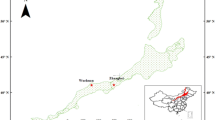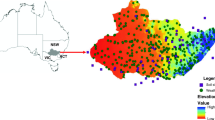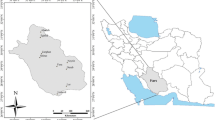Abstract
Climate models indicate that increasing atmospheric concentrations of greenhouse gases (GHG), mainly CO2, will alter climate by increasing temperatures and changing rainfall patterns. Considering that potato crop stands out as the most important non-grain crop in the world, it is imperative to understand how climate change will impact this crop and how it will affect global food security. In this sense, crop simulation models are useful tools to estimate crop growth, development and yield in response to climatic conditions, soils, genotype and crop management. Among the several potato crop simulation models, DSSAT-SUBSTOR-Potato is the main one and widely used around the world. The aim of this study was to validate this model for Brazilian conditions and used it to simulate the impacts of projected climate change on potato crop in the main Brazilian producing regions, for different growing seasons, considering an ensemble of different general circulation models, projected for 2040–2069 and 2070–2099 periods, under two GHG Representative Concentration Pathways (RCP4.5 and RCP8.5). The results showed that Brazil will have warmer climate with wetter conditions in the south and less rainfall in the north, which will impact potato crop in different ways, depending on the producing region and growing season. In Southern Brazil, future climate will benefit potato yield, mainly during the 3rd growing season. On the other hand, locations with warmer and drier climates will have lower potato yields in relation to the present, mostly during the 1st growing season, when extremely high temperatures and water deficit will limit plants’ growth. These impacts will be less expressive in the most optimist scenario (RCP4.5), while more intense yield losses are expected under the RCP8.5 in the end of the century.








Similar content being viewed by others
References
Adavi, Z., Moradi, R., Saeidnejad, A. H., Tadayon, M. R., & Mansouri, H. (2018). Assessment of potato response to climate change and adaptation strategies. Science Horticulture, 228, 91–102. https://doi.org/10.1016/j.scienta.2017.10.017.
Adhikari, U., Nejadhashemi, A. P., & Woznicki, S. A. (2015). Climate change and eastern Africa: A review of impact on major crops. Food Energy Security, 4(2), 110–132. https://doi.org/10.1002/fes3.61.
Allen, R. G., Pereira, L. S., Raes, D., & Smith, M. (1998). Crop evapotranspiration: Guidelines for computing crop water requirements. FAO Irrigation and Drainage Paper 56, Rome.
Alves, L. M. (2009). Clima da Região Centro-Oeste do Brasil. In I. F. A. Cavalcanti, N. J. Ferreira, M. A. F. Silva Dias, & M. G. A. J. Silva (Eds.), Tempo e Clima no Brasi (1a ed., pp. 235–241). São Paulo, Brazil: Oficina de textos.
Ängström, A. (1924). Solar and terrestrial radiation. Quarterly Journal of Royal Meteorological Society, 50, 121–126. https://doi.org/10.1002/qj.49705021008.
Angulo, C., Rötter, R., Lock, R., Enders, A., Fronzek, S., & Ewert, F. (2013). Implication of crop model calibration strategies for assessing regional impacts of climate change in Europe. Agricultural and Forest Meteorology, 170, 32–46. https://doi.org/10.1016/j.agrformet.2012.11.017.
Asseng, S., Zhu, Y., Wang, E., & Zhang, W. (2015). Crop modeling for climate change impact and adaptation. In V. O. Sadras & D. F. Calderini (Eds.), Crop physiology: Applications for genetic improvement and agronomy (2nd ed., pp. 505–546). San Diego: Academic Press. https://doi.org/10.1016/B978-0-12-417104-6.00020-0.
Battisti, R., Bender, F. D., & Sentelhas, P. C. (2018a). Assessment of different gridded weather data for soybean yield simulations in Brazil. Theoretical and Applied Climatology, 135(1/2), 237–247. https://doi.org/10.1007/s00704-018-2383-y.
Battisti, R., Sentelhas, P. C., Parker, P. S., Nendel, C., Câmara, G. M. S., Farias, J. R. B., et al. (2018b). Assessment of crop-management strategies to improve soybean resilience to climate change in Southern Brazil. Crop and Pasture Science, 69(2), 154–162. https://doi.org/10.1071/CP17293.
Bender, F. D., & Sentelhas, P. C. (2018). Solar radiation models and gridded databases to fill gaps in weather series and to project climate change in Brazil. Advances in Meteorology, 2018, 15. https://doi.org/10.1155/2018/6204382.
Boote, K. J., Jones, J. W., & Pickering, N. B. (1996). Potential uses and limitations of crop models. Agronomy Journal, 88(5), 704–716. https://doi.org/10.2134/agronj1996.00021962008800050005x.
Camargo, A. P., & Sentelhas, P. C. (1997). Avaliação do desempenho de diferentes métodos da evapotranspiração potencial no estado de São Paulo, Brasil. Revista Brasileira de Agrometeorologia, 5(1), 89–97.
Costa, L. C., Justino, F., Oliveira, L. J. C., Sediyama, G., Ferreira, W. P. M., & Lemos, C. F. (2009). Potential forcing of CO2, technology and climate changes in maize (Zea mays) and bean (Phaseolus vulgaris) yield in southeast Brazil. Environmental Research Letters, 4(1), 10. https://doi.org/10.1088/1748-9326/4/1/014013.
do Rio, A., Sentelhas, P. C., Farias, J. R. B., Sibaldelli, R. N. R., & Ferreira, R. C. (2015). Alternative sowing dates as a mitigation measure to reduce climate change impacts on soybean yields in southern Brazil. International Journal of Climatology, 36(11), 3664–3672. https://doi.org/10.1002/joc.4583.
dos Santos, D. L., & Sentelhas, P. C. (2014). Climate change scenarios and their impact on water balance and sugarcane yield in southern Brazil. Sugar Tech, 16(4), 356–365. https://doi.org/10.1007/s12355-013-0293-y.
Elli, E. F., Huth, N., Sentelhas, P. C., Carneiro, R. L., & Alvares, C. A. (2020a). Global sensitivity-based modelling approach to identify suitable Eucalyptus traits for adaptation to climate variability and change. In Silico Plants, 2, 1–17. https://doi.org/10.1093/insilicoplants/diaa003.
Elli, E. F., Sentelhas, P. C., & Bender, F. D. (2020b). Impacts and uncertainties of climate change projections on Eucalyptus plantations productivity across Brazil. Forest Ecology and Management. https://doi.org/10.1016/j.foreco.2020.118365.
FAOSTAT. (2020). Food and agriculture organization of the United Nation Statistics. Retrieved from: http://www.fao.org/faostat/en/#data/QC. Accessed 27 Apr 2020.
Fleisher, D. H., Condori, B., Quiroz, R., Alva, A., Asseng, S., Barreda, C., et al. (2017). A potato model intercomparison across varying climates and productivity levels. Global Change Biology, 23(3), 1258–1281. https://doi.org/10.1111/gcb.13411.
Glover, J., & McCulloch, J. S. G. (1958). The empirical relation between solar radiation and hours of sunshine. Quarterly Journal Royal Meteorological Society, 84(360), 172–175. https://doi.org/10.1002/qj.49708436011.
Griffin, T. S., Johnson, B. S, & Ritchie, J. T. (1993). A simulation model for potato growth and development: Substor-Potato Version 2.0. IBSNAT Research Report Series 02. Dept. of Agronomy and Soil Science, College of Tropical Agriculture and Human Resources, Univ. of Hawaii, Honolulu, HI, USA.
Grimm, A. M. (2009). Clima da Região Sul do Brasil. In I. F. A. Cavalcanti, N. J. Ferreira, M. A. F. Silva Dias, & M. G. A. J. Silva (Eds.), Tempo e Clima no Brasil (1a ed., pp. 259–275). São Paulo, Brasil: Oficina de textos.
Hijmans, R. J. (2003). The effect of climate change on global potato production. American Journal of Potato Research, 80(4), 271–279. https://doi.org/10.1007/BF02855363.
Hoogenboom, G., Porter, C. H., Shelia, V., Boote, K. J., Singh, U., White, J. W., Hunt, L. A., Ogoshi, R., Lizaso, J. I., Koo, J., Asseng, S., Singels, A., Moreno, L. P., & Jones, J. W. (2017) Decision support system for agrotechnology transfer (DSSAT) Version 4.7 (http://www.DSSAT.net). DSSAT Foundation, Gainesville, Florida, USA.
Hudson, N. I., & Ruane, A. C. (2015). Appendix 2. Guide for running AgMIP climate scenario generation tools with R in Windows, Version 2.3. In C. Rosenzweig & D. Hillel (Eds.), Handbook of climate change and agroecosystems: The agricultural model intercomparison and improvement project (AgMIP) integrated crop and economic assessments, part 1. ICP series on climate change impacts, adaptation, and mitigation (pp. 287–440). London: Imperial College Press.
IBGE. (2020). Agricultural production (In Portuguese). Retrieved from: http://www.sidra.ibge.gov.br/bda/pesquisas/pam/default.asp?o=18&i=P. Accessed 18 July 2020.
IPCC. (2013). Climate change 2013: The physical science basis. In T. F. Stocker, D. Qin, G.-K. Plattner, M. Tignor, S. K. Allen, J. Boschung, A. Nauels, Y. Xia, V. Bex, & P. M. Midgley (Eds.), Contribution of working group I to the fifth assessment report of the intergovernmental panel on climate change. Cambridge: Cambridge University Press. https://doi.org/10.1017/CBO9781107415324.
IPCC. (2014). Climate change 2014: Impacts, adaptation, and vulnerability. In V. R. Barros, C. B. Field, D. J. Dokken, M. D. Mastrandrea, K. J. Mach, T. E. Bilir, M. Chatterjee, K. L. Ebi, Y. O. Estrada, R. C. Genova, B. Girma, E. S. Kissel, A. N. Levy, S. Mac Cracken, P. R. Mastrandrea, & L. L. White (Eds.), Part B: Regional aspects. Contribution of working group II to the fifth assessment report of the intergovernmental panel on climate change. Cambridge: Cambridge University Press. https://doi.org/10.1017/CBO9781107415386.
Kaminski, K. P., Kørup, K., Nielsen, K. L., Liu, F., Topbjerg, H. B., Kirk, H. G., et al. (2014). Gas-exchange, water use efficiency and yield responses of elite potato (Solanum tuberosum L.) cultivars to changes in atmospheric carbon dioxide concentration, temperature and relative humidity. Agriculture Forest Meteorology, 187, 35–45. https://doi.org/10.1016/j.agrformet.2013.12.001.
Kleinwechter, U., Gastelo, M., Ritchie, J., Nelson, G., & Asseng, S. (2016). Simulating cultivar variations in potato yields for contrasting environments. Agriculture System, 145, 51–63. https://doi.org/10.1016/j.agsy.2016.02.011.
Liu, X., Andresen, J., Yang, H., & Niyogi, D. (2015). Calibration and validation of the hybrid-maize crop model for regional analysis and application over the U.S. corn belt. Earth Interaction, 19, 16. https://doi.org/10.1175/EI-D-15-0005.1.
Lutz, A. F., Maat, H. W., Biemans, H., Shrestha, A. B., Wester, P., & Immerzeel, W. W. (2016). Selecting representative climate models for climate change impact studies: An advanced envelope-based selection approach. International Journal of Climatology, 36(12), 3988–4005. https://doi.org/10.1002/joc.4608.
Mancosu, N., Snyder, R. L., Kyriakakis, G., & Spano, D. (2015). Water scarcity and future challenges for food production. Water, 7, 975–992. https://doi.org/10.3390/w7030975.
Marin, F. R., Jones, J. W., Singels, A., Royce, F., Assad, E. D., Pellegrino, G. Q., et al. (2013). Climate change impacts on sugarcane attainable yield in southern Brazil. Climate Change, 117(1–2), 227–239. https://doi.org/10.1007/s10584-012-0561-y.
Massetti, E., Guiducci, R., do, C. N., Oliveira, A. F., & Mendelsohn, R. A. (2013). The impact of climate change on the brazilian agriculture: A ricardian study at microregion level. SSRN, 200, 31. https://doi.org/10.2139/ssrn.2637287.
Moss, R. H., Edmonds, J. A., Hibbard, K. A., Manning, M. R., Rose, S. K., van Vuuren, D. P., et al. (2010). The next generation of scenarios for climate change research and assessment. Nature, 463, 747–756. https://doi.org/10.1038/nature08823.
Nunes, L. H., Vicente, A. K., & Candido, D. H. (2009). Clima da Região Sudeste do Brasil. In I. F. A. Cavalcanti, N. J. Ferreira, M. A. F. Silva Dias, & M. G. A. J. Silva (Eds.), Tempo e Clima no Brasil (1a ed., pp. 243–258). São Paulo, Brazil: Oficina de textos.
Prescott, J. A. (1940). Evaporation from water surface in relation to solar radiation. Transaction Royal Society of South Australia, 64, 114–118. https://doi.org/10.1155/2013/168048.
RADAMBRASIL. (1981). Levantamento de recursos naturais. Rio de Janeiro, Brazil: Departamento Nacional de Produção Mineral (DNPM).
Rahman, A., Mojid, M. A., & Banu, S. (2018). Climate change impact assessment on three major crops in the north-central region of Bangladesh using DSSAT. International Journal of Agricultural and Biological Engineering, 11(4), 135–143. https://doi.org/10.25165/j.ijabe.20181104.3331.
Raymundo, R., Asseng, S., Prassad, R., Kleinwechter, U., Concha, J., Condori, B., et al. (2017a). Performance of the SUBSTOR-potato model across contrasting growing conditions. Field Crop Research, 202, 57–76. https://doi.org/10.1016/j.fcr.2016.04.012.
Raymundo, R., Asseng, S., Robertson, R., Petsakos, A., Hoogenboom, G., Quiroz, R., et al. (2017b). Climate change impact on global potato production. European Journal of Agronomy, 100, 87–98. https://doi.org/10.1016/j.eja.2017.11.008.
Reboita, M. S., da Rocha, R. P., Dias, C. G., & Ynoue, R. Y. (2014). Climate projections for South America: RegCM3 driven by HadCM3 and ECHAM5. Advance Meteorology, 2014, 17. https://doi.org/10.1155/2014/376738.
Resop, J. P., Fleisher, D. H., Timlin, D. J., Mutiibwa, D., Reddy, V. R., Island, R., et al. (2016). Water management, and land use: Estimating potential potato and corn production in the US Northeastern Seaboard Region. Transactions of the ASABE, 59(6), 1539–1553. https://doi.org/10.1303/trans.59.11748.
Ritchie, J. T. (1998). Soil water balance and plant water stress. In G. Y. Tsuji, G. Hoogenboom, & K. Thornton (Eds.), Understanding options of agricultural production (pp. 41–53). Dordrecht, The Netherlands: Kluwer Academic Publishers and International Consortium for Agricultural Systems Applications.
Rosenzweig, C., Jones, J. W., Hatfield, J. L., Antle, J. M., Ruane, A. C., Boote, K. J., et al. (2015). Appendix 1. Guide for regional integrated assessments: Handbook of methods and procedures, version 5.1. In C. Rosenzweig & D. Hillel (Eds.), Handbook of climate change and agroecosystems: The agricultural model intercomparison and improvement project (AgMIP) integrated crop and economic assessments, part 1. ICP series on climate change impacts, adaptation, and mitigation (Vol. 3, pp. 331–386). London: Imperial College Press.
Rosenzweig, C., Jones, J. W., Hatfield, J. L., Ruane, A. C., Boote, K. J., Thorburn, P., et al. (2013). The agricultural model intercomparison and improvement project (AgMIP): Protocols and pilot studies. Agricultural Forest Meteorology, 170, 166–182. https://doi.org/10.1016/j.agrformet.2012.09.011.
Ruane, A. C., & McDermid, S. P. (2017). Selection of a representative subset of global climate models that captures the profile of regional changes for integrated climate impacts assessment. Earth Perspectives, 4, 1. https://doi.org/10.1186/s40322-017-0036-4.
Ruane, A. C., Winter, J. M., McDermid, S. P., & Hudson, N. I. (2015). AgMIP climate datasets and scenarios for integrated assessment. In C. Rosenzweig & D. Hillel (Eds.), Handbook of climate change and agroecosystems: The agricultural model intercomparison and improvement project (AgMIP). ICP Series on climate change impacts, adaptation, and mitigation. Part 1 (Vol. 3, pp. 45–78). London: Imperial College Press.
Sadras, V., Calderini, D., & Connor, D. (2009). Sustainable agriculture and crop physiology. In V. Sadras & D. Calderini (Eds.), Crop physiology. Applications for genetic improvement and agronomy (pp. 1–19). Burlington, MA: Academic Press.
Sánchez, E., Solman, S., Remedio, A. R. C., Berbery, H., Samuelsson, P., Da Rocha, R. P., et al. (2015). Regional climate modelling in CLARIS-LPB: A concerted approach towards twentyfirst century projections of regional temperature and precipitation over South America. Climate Dynamics, 45(7–8), 2193–2212. https://doi.org/10.1007/s00382-014-2466-0.
Semenov, M. A., & Stratonovitch, P. (2015). Adapting wheat ideotypes for climate change: Accounting for uncertainties in CMIP5 climate projections. Climate Research, 65, 123–139. https://doi.org/10.3354/cr01297.
Silva, G. O., & Lopes, C. A. (2015). Sistema de produção da batata, 2nd edn. Brasília, DF: Embrapa. (Embrapa Hortaliças. Sistema de Produção, 8; Embrapa Clima Temperado. Sistema de Produção, 18; Embrapa Produtos e Mercado, Sistema de Produção, 1). Retrieved from: http://ainfo.cnptia.embrapa.br/digital/bitstream/item/132923/1/Sistema-de-Producao-da-Batata.pdf. Accessed 26 Nov 2018.
Soil Conservation Service (SCS). (1972). National engineering handbook. Hydrology Section 4, Chapters 4/10.
Suleiman, A. A., & Ritchie, J. T. (2003). Modeling soil water redistribution during second-stage evaporation. Soil Science Society of America Journal, 67(2), 377–386. https://doi.org/10.2136/sssaj2003.3770.
Taylor, K. E., Stouffer, R. J., & Meehl, G. A. (2012). An overview of CMIP5 and the experiment design. Bulletin of the American Meteorological Society, 93, 485–498. https://doi.org/10.1175/BAMS-D-11-00094.1.
Tomasella, J., Hodnett, M. G., & Rossato, L. (2000). Pedotransfer functions for the estimation of soil water retention in Brazilian soils. Soil Science Society of America Journal, 64(1), 327–338. https://doi.org/10.2136/sssaj2000.641327x.
Torres, R. R., & Marengo, J. A. (2013). Uncertainty assessments of climate change projections over South America. Theoretical and Applied Climatology, 112(1–2), 253–272. https://doi.org/10.1007/s00704-012-0718-7.
Wallach, D., Makowski, D., Jones, J. W., & Brun, F. (2013). Working with dynamic crop models. methods tools and examples for agriculture and environment. London: Academic Press.
Ward, J. D., Werner, A. D., Nel, W. P., & Beecham, S. (2011). The influence of constrained fossil fuel emissions scenarios on climate and water resource projections. Hydrology Earth System Science, 15, 1879–1893. https://doi.org/10.5194/hess-15-1879-2011.
Willmott, C. J., Ackleson, S. G., Davis, R. E., Feddema, J. J., Klink, K. M., Legates, D. R., et al. (1985). Statistics for the evaluation and comparison of models. Journal of Geophysical Research: Oceans, 90(C5), 8995–9005. https://doi.org/10.1029/JC090iC05p08995.
Xavier, A. C., King, C. W., & Scanlon, B. R. (2015). Daily gridded meteorological variables in Brazil (1980–2013). International Journal of Climatology, 36(6), 2644–2659. https://doi.org/10.1002/joc.4518.
Acknowledgements
We would like to thank the Brazilian National Council for Scientific and Technological Development (CNPq) for the support to this study through a postdoctoral scholarship (Process Nº 150243/2018-9) and a research fellowship (Process Nº 301299/2017-0), for first and second authors, respectively.
Author information
Authors and Affiliations
Corresponding author
Ethics declarations
Conflict of interest
The authors declare that there is no conflict of interest regarding the publication of this article.
Electronic supplementary material
Below is the link to the electronic supplementary material.
Rights and permissions
About this article
Cite this article
Bender, F.D., Sentelhas, P.C. Assessment of Regional Climate Change Impacts on Brazilian Potato Tuber Yield. Int. J. Plant Prod. 14, 647–661 (2020). https://doi.org/10.1007/s42106-020-00111-7
Received:
Accepted:
Published:
Issue Date:
DOI: https://doi.org/10.1007/s42106-020-00111-7




